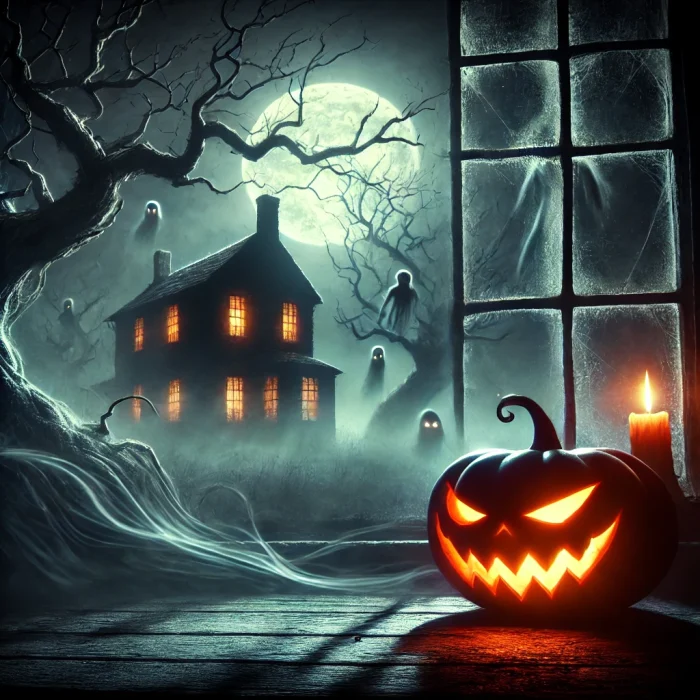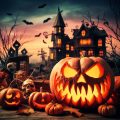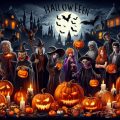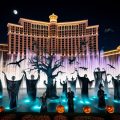
Ancient Origins: The Celtic Festival of Samhain
Halloween’s origins trace back over 2,000 years to the ancient Celtic festival of Samhain (pronounced “Sow-in”), celebrated on November 1st in what is now Ireland, the United Kingdom, and northern France. The Celts believed that on the night before Samhain, October 31st, the boundary between the living and the dead became blurred. On this eerie night, the spirits of the dead would return to earth, causing mischief and damage to crops. To appease these restless spirits, the Celts built massive bonfires, offering sacrifices of crops and animals to their gods.
The fear of wandering spirits led villagers to disguise themselves in animal skins or spooky costumes, blending in with the supernatural beings that roamed the night. These disguises were the first “costumes” of Halloween, meant to trick malevolent ghosts into thinking the living were one of them.
Roman Influence and the Birth of All Hallows’ Eve
When the Romans conquered Celtic lands around 43 AD, they combined their own traditions with Samhain. Two Roman festivals, Feralia—honoring the dead—and Pomona, a harvest festival dedicated to the goddess of fruit and trees, merged with the Celtic celebrations. Pomona’s symbol was the apple, which could explain why we bob for apples on Halloween today.
By the 9th century, the influence of Christianity spread across Europe, and the Catholic Church sought to replace the pagan festival with a more acceptable alternative. In 1000 AD, the Church designated November 1st as All Saints’ Day, or “All Hallows,” a day to honor saints and martyrs. The evening before All Saints’ Day became known as All Hallows’ Eve, eventually morphing into the Halloween we know today.
The Witch Hunts and Superstitions
During the Middle Ages, Halloween took on even more sinister tones. With widespread beliefs in witchcraft, witches were thought to be active on Halloween night, casting spells and summoning the dead. People carried lanterns made from hollowed-out turnips with faces carved into them to ward off evil spirits—precursors to today’s jack-o’-lanterns. These flickering lanterns in dark windowsills and doorways created a spine-chilling glow, adding to the eerie ambiance.
In the 16th and 17th centuries, the fear of witches grew into a deadly hysteria, with infamous witch hunts in Europe and America. Halloween became associated with witches flying on broomsticks, black cats (believed to be their familiars), and secret midnight rituals. Some of these superstitions still linger today, as black cats crossing your path on Halloween is still thought to bring bad luck.
The Arrival of Halloween in America
When European immigrants, especially the Irish fleeing the Great Potato Famine, arrived in America in the 19th century, they brought their Halloween traditions with them. However, it wasn’t until the late 1800s that Halloween started gaining popularity in the United States. By the early 20th century, it evolved into a community-centered holiday, with town-wide parties, costume parades, and games.
Trick-or-treating, one of Halloween’s most beloved traditions, has roots in both early Celtic customs and a medieval practice known as “souling.” On All Souls’ Day, poor people would visit the homes of wealthier families, offering prayers for their dead in exchange for food. This practice morphed into children going door-to-door in costumes, asking for treats to avoid tricks or pranks.
Haunted Houses and Horror Icons
As Halloween grew, so did its focus on fear. By the mid-20th century, haunted houses became a popular attraction, with terrifying mazes and ghostly apparitions designed to give people a thrilling fright. The rise of horror movies in the 1970s and 80s cemented Halloween’s status as the night of terror. Films like Halloween, Friday the 13th, and Nightmare on Elm Street brought iconic horror characters like Michael Myers, Jason Voorhees, and Freddy Krueger into the Halloween tradition, terrifying generations of thrill-seekers.
Halloween Today: Fear, Fun, and Frights
Today, Halloween is a global phenomenon, celebrated with spooky decorations, eerie costumes, and haunted attractions that get scarier every year. Despite its commercialized appearance, the holiday retains a connection to its dark past. Even as people carve pumpkins and don costumes for fun, there’s still an air of mystery and fear surrounding October 31st. On this night, when the veil between worlds is thinnest, you might just feel a chill in the air—and wonder if a ghostly visitor from the past is closer than you think.
As you venture out this Halloween, remember: the traditions we love are rooted in ancient rituals and superstitions. Whether you’re trick-or-treating or exploring a haunted house, you’re taking part in a celebration that’s far older—and spookier—than it seems. Keep your lanterns lit, and beware the spirits who might be lurking in the shadows…
Disclaimer: The information presented in this article is based on the available data and historical records around the time of publication. While we strive to provide accurate and comprehensive details, Halloween’s history is a mix of folklore, legend, and fact. We encourage you to explore more sources to deepen your knowledge of this fascinating and spooky holiday. Las Vegas Top Picks does its best to get stories accurate, but sometimes mistakes and biases happen. It’s always a good idea to double-check other media outlets and historical sources for verification.








